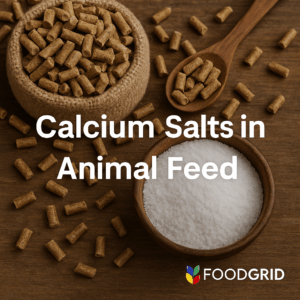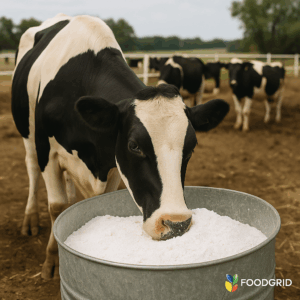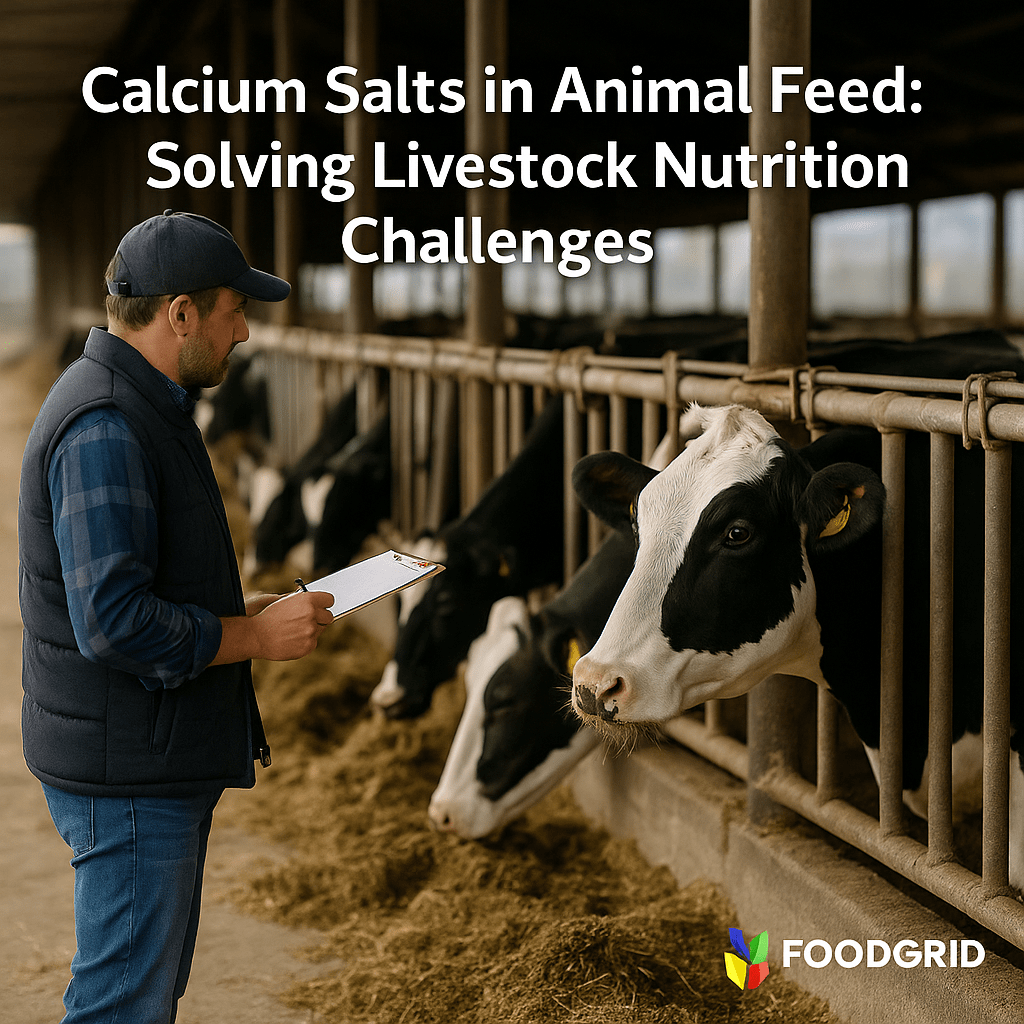For dairy producers, keeping cows productive, healthy, and resilient is central to profitability in today’s competitive environment. Feed formulation is a key lever—and among the many nutritional additives available, calcium salts stand out as reliable solutions that go far beyond basic bone health.
These compounds are essential performance drivers, particularly during the high-stress transition and peak lactation periods. Correctly formulated calcium salts, such as specialized forms of limestone (calcium carbonate) or highly available sources like calcium propionate, are critical for maintaining metabolic stability. They are indispensable for managing the complex process of calcium mobilization, directly influencing the successful prevention of disorders like Milk Fever (hypocalcemia), which can devastate a fresh cow’s performance and longevity. Furthermore, strategically using calcium salts as buffers helps stabilize rumen pH in high-energy diets, ensuring maximum efficiency from the total mixed ration (TMR) and protecting overall gut health. Ultimately, investing in precision calcium supplementation directly translates to higher milk yield, improved feed efficiency, and robust herd resilience.
The Dairy Challenge: Milk Fever and Energy Deficit
The Problem
High-yielding dairy cows—particularly during the transition and early lactation periods—face two critical challenges:
Negative energy balance that limits peak milk production.
Hypocalcemia (milk fever), which increases the risk of poor fertility, metabolic stress, and veterinary costs.
The Calcium Salt Solution
Calcium salts of fatty acids deliver concentrated, rumen-protected energy to support higher milk yield and butterfat.
Calcium carbonate helps maintain skeletal strength and rumen pH stability.
Result: Better energy efficiency, higher productivity, and reduced incidence of metabolic disease.
Practical Benefits for Dairy Nutrition Partners
Enhanced Milk Yield & Components: Cows supplemented with calcium salts of fatty acids often achieve +2–4 kg/day more milk and +0.5–0.8% higher butterfat.
Transition Cow Health: Correct supplementation reduces cases of hypocalcemia and supports faster recovery postpartum.
Metabolic Stability: Consistent calcium supports muscle contraction, nerve function, and reproductive performance.
Compliance & Market Access: EU-approved (E170) calcium sources align with export market requirements.

Common Challenges and Solutions
1. Hypocalcemia in Transition Cows
Cause: Low available calcium at calving.
Fix: Supplement with calcium carbonate in pre-fresh diets and calcium salts of fatty acids post-fresh for energy + calcium support.
2. Mineral Interactions
Cause: Excess calcium can suppress phosphorus absorption.
Fix: Maintain a Ca:P ratio of 1.5–2:1 in lactating cow diets.
3. Handling & Mixing Issues
Cause: Fine powders may lead to dust and uneven mixing.
Fix: Choose granulated or coated calcium sources for better flowability in TMR systems.
Economic ROI for Dairy Farm Owners & Managers
Milk Yield: +2–4 kg/day per cow.
Milk Fat: +0.5–0.8% increase = higher milk check premiums.
Health Costs: Reduced metabolic disorders lower veterinary interventions.
Profitability: For a 500-cow herd, optimized calcium supplementation can add $50,000–$70,000 annually in milk revenue.
Supplier and Sourcing Insights
Preferred Formats: Palletized 1-ton lots for efficiency in large-scale feeding.
Trusted Suppliers: Established providers such as Megalac and Valudor.
Buying Criteria: GMP+ certification, rumen stability, consistent particle size, and proven ROI on production.

Feeding Guidelines for Ruminant Feed Specialists
Transition Cows: 100–150 g/day calcium salts of fatty acids.
Lactating Cows: 2–3% DM inclusion for yield and component improvement.
Dry Cows: Controlled calcium carbonate with DCAD diets to prevent milk fever.
Tip: Monitor butterfat %, milk yield, and incidence of hypocalcemia to measure program effectiveness.
Strategic Calcium Salt Inclusion by Production Stage
Optimizing calcium salt inclusion requires precision, as the cow’s physiological needs change drastically across the lactation cycle. Specialists must tailor the form and quantity to match specific demands.
Transition Cows (Pre- and Post-Calving)
The transition period (three weeks pre- to three weeks post-calving) is the most metabolically demanding phase.
- Targeted Supplementation: 100–150 g/day of calcium salts of fatty acids (rumen-protected fats).
- Rationale: This targeted amount delivers a high concentration of non-glucogenic energy directly to the small intestine, bypassing rumen biohydrogenation. This critical energy boost helps mitigate the severe Negative Energy Balance (NEB) and reduces the risk of ketosis, supporting the cow’s system as it simultaneously tries to initiate lactation and mobilize body reserves.
Lactating Cows (Peak to Mid-Lactation)
Once lactation is established, the focus shifts to maximizing milk output and components while maintaining health.
- Inclusion Rate: 2–3% of Dry Matter (DM) inclusion for calcium salts of fatty acids.
- Rationale: Incorporating rumen-protected fats at this higher rate provides sustained, dense energy input, which directly supports increased milk yield and improved butterfat percentage. The calcium component of these salts also contributes to the cow’s high daily calcium requirement for milk synthesis, acting as a crucial building block for production.
Dry Cows (Far-Off and Close-Up)
The goal during the dry period is to prepare the cow for the next lactation and calving event.
- Inclusion Strategy: Controlled use of calcium carbonate combined with DCAD (Dietary Cation-Anion Difference) diets.
- Rationale:
- Far-Off: Calcium carbonate is used as the baseline mineral source.
- Close-Up: The priority is to restrict high calcium sources and incorporate anionic salts to create a negative DCAD. This acidifying action forces the cow’s endocrine system to activate its natural calcium-mobilizing hormones (like PTH and Vitamin D), ensuring she can pull calcium from her bones quickly when the sudden demand of calving hits. Calcium Carbonate must be strictly controlled or removed from the close-up diet as it acts as a base and counteracts the required acidification.
Internal Resources for Further Exploration
For more insights on optimizing feed strategies, explore FoodGrid’s resources:
References
- University of Wisconsin–Madison Dairy Science
- Journal of Dairy Science – Effects of Calcium Salts of Fatty Acids
Calcium salts have proven their value as reliable feed additives, moving beyond basic supplementation to become key performance drivers in dairy production. From preventing milk fever and metabolic disorders in the crucial transition period to stabilizing rumen pH and supporting peak milk production, they solve real challenges in dairy farming—driving both cow health and profitability.
👉 Explore FoodGrid’s calcium solutions here: https://foodgridinc.com/ and connect with us to design feed strategies that address your livestock or aquaculture challenges directly.
